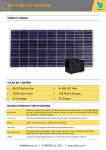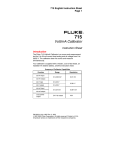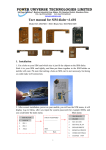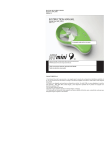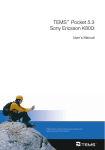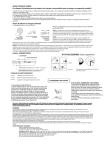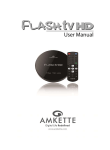Download Sony Ericsson K618i User's Manual
Transcript
Formatting video for local playback
Introduction
This document introduces the broader concepts of digital video multimedia, and the specific details of formatting
video for Sony Ericsson phones using local storage and playback. A practical example of the process is also
included.
People who may benefit from this document include:
• Content providers.
• Software developers.
• Operators and service providers.
The competence required to follow this document extends only to basic computer skills, as all concepts are fully
explained. Prior experience with editing or formatting digital video is advantageous.Sony Ericsson mobile phones
that are covered by this document:
Generic names series
Sony Ericsson Mobile Phones
K800
K800i, K800c, K800a
K790
K790i, K790c, K790a
K750
K750i, K750c, D750
K610
K610im, K610i, K610c, K618i
W900
W900i
W850
W850i, W850c
W810
W810i, W810c, W810a
W800
W800i, W800c
W600
W600i
W550
W550i, W550c
W300
W300i, W300c
Z610
Z610i
K800
K800i, K800c, K800a
K790
K790i, K790c, K790a
K750
K750i, K750c, D750
K610
K610im, K610i, K610c, K618i
W900
W900i
W850
W850i, W850c
Generated by Clearspace on 2008-05-18-05:00
1
Formatting video for local playback
W810
W810i, W810c, W810a
W800
W800i, W800c
W600
W600i
W550
W550i, W550c
W300
W300i, W300c
Z610
Z610i
Note: Other Sony Ericsson phones can support the same containers and compression codecs as the phones
listed here, however the exact parameters needed to encode videos for those phones may differ. As such it is
recommended to verify successful playback on those phones when creating video for them.
Terminology
Anti-aliasing \- The technique of minimizing aliasing (jagged or blocky patterns) when representing a high-resolution
signal at a lower resolution. In most cases, anti-aliasing means removing data at too high a frequency to represent.
When sampling is performed without removing this part of the signal, it causes undesirable artifacts such as
black-and-white noise.
Aspect Ratio \- The ratio of pixels in width to pixels in height.
Audio Normalisation \- The process of adding volume gain to the audio track up to the point just before distortion or
clipping will occur.
Bit Rate \- The number of bits used to compress a data stream, typically measured in kilobits-per-second (kbps).
Codec \- COmpressor/DECompressor an algorithm that compresses and decompresses data streams.
Container \- The package that video and audio streams are placed in, to ensure synchronised playback.
Data Stream \- The encoded video data.
Decoding \- Decompressing a data stream through a codec.
Frame Rate \- The number of video frames displayed every second.
Encoding \- Compressing a data stream through a codec.
IsoMedia \- A generic name for all formats based on the MPEG-4 Part 12 specification: MP4 and 3GP.
Lossy Compression \- A codec that discards some data when encoding a data stream.
Mono Sound \- Audio consisting of a single channel.
Multimedia \- Video Media file containing video and audio tracks.
Multiplexing \- The act of placing data streams inside a container, also referred to as muxing.
Pixel Resolution \- The number of pixels used in an image, as height by width.
Rendering \- The process of applying timeline instructions for effects to produce a video file.
Sample Rate \- The number of audio samples per second, measured in KHz or Hz.
Generated by Clearspace on 2008-05-18-05:00
2
Formatting video for local playback
Sampling \- The act of taking a portion of one sound recording, the sample, and reusing it as an instrument or
element of a new recording.
Stereo Sound \- Audio consisting of two channels, left and right.
Streaming \- A method for making audio, video and other multimedia available in near realtime, that is the user can
begin to watch or hear the content of a downloaded media file after only a short delay. Previously it was necessary to
download an entire file before playing it.
Transcoding \- Encoding an already compressed data stream to a different codec.
Abreviations
3GP - A multimedia container format defined by 3GPP for use on 3G mobile phones. It is a simplified version of
MPEG-4 Part 14 (MP4). 3GP files have the filename extension .3gp or .3g2. 3GP stores video streams as MPEG-4
or H.263, and audio streams as AMR-NB or AAC-LC formats.
3GPP \- 3rd Generation Partnership Project.
3ivx \- A commercial video codec suite that allows the creation of MPEG-4 compliant data streams.
AAC \- Advanced Audio Coding.
AAC-LC \- Advanced Audio Coding. Low Complexity.
AC3 \- Audio File Format.
AIFF \- Audio Interchange File.
AMR \- Adaptive Multi-Rate (NB = NarrowBand, WB = WideBand).
AVI \- Audio Video Interleave Container File.
CBR \- Constant Bit Rate.
DivX \- Video Codec. DivX has the ability to compress lengthy video segments into small sizes while maintaining
relatively high visual quality. DivX uses lossy MPEG-4 Part 2 compression.
ETSI \- European Telecommunications Standards Institute.
FLAC \- Free Lossless Audio Codec.
H.263 \- Video Codec. Predecessor of H.264.
H.264 \- Also known as MPEG-4 AVC (Advanced Video Coding), is a video compression standard that offers
significantly greater compression than its predecessors, for example, MPEG-4 ASP (Advanced Simple Profile).
M4A \- MPEG-4 Audio Layer.
MOV \- QuickTime Video Clip.
MP3 \- MPEG Audio Stream, Layer 3.
MP4 \- MPEG-4 Video File.
Generated by Clearspace on 2008-05-18-05:00
3
Formatting video for local playback
MPEG \- Moving Picture Experts Group, develops standards for digital video and digital audio compression. The
MPEG standards are an evolving series, each designed for a different purpose.
MPG \- MPEG-1 file.
OGG \- Ogg Vorbis Codec Compressed WAV File. An open source patent-free audio compression format. Vorbis
files compress to a smaller size than MP3 files.
PCM \- Pulse code modulation. A digital scheme for transmitting analog data. Using PCM, it is possible to digitize all
forms of analog data, including full-motion video, voices, music, telemetry, and virtual reality (VR). QCIF \- Quarter
Common Intermediate Format. Video encoding format with 176 × 144 resolution.
QVGA \- Quarter Video Graphics Array. 320 × 240 resolution.
VBR \- Variable Bit Rate.
WAV \- Waveform Audio File.
WMA \- Windows Media Audio File.
WMV \- Windows Media Video File.
XviD \- A free and open source MPEG-4 video codec. XviD features MPEG-4 advanced simple profile features.
Trademarks and aknowledgements
Vegas™ is a trademark or registered trademark of Sony Corporation.
Microsoft® and Windows® are either registered trademarks or trademarks of Microsoft Corporation in the
United States and/or other countries.
Apple, QuickTime and Final Cut are a trademarks of Apple Computer, Inc., registered in the U.S. and other
countries.
Premiere™, After Effects™ and Audition™ are trademarks or registered trademarks of Adobe Systems
Incorporated.
Nero is a registered trademark of Nero AG.
3GPP is a trademark or registered trademark of ETSI.
Other product and company names mentioned herein may be the trademarks of their respective owners.
{*}Components of digital multimedia video{*}
Digital multimedia video generally consists of two major elements; a video track, with an accompanying audio track.
These tracks or components of the video are termed data streams. Although typically there is one data stream for
video and another for audio, it is also possible for more than two data streams to be present. An example of this
is the commentary feature found on many DVDs, where the second of two audio data streams can be chosen to
accompany the video stream.
Generated by Clearspace on 2008-05-18-05:00
4
Formatting video for local playback
Resolution
Both visible and audible information are naturally analogue mediums. This analogue information must be sampled to
be stored digitally. The number of samples dictates the resolution of the digital copy, with more samples improving
the resolution and definition. Within the scope of this document and its purpose, there are only four digital sample
resolutions that are relevant. The first is the visual resolution of the video stream, measured in pixels as width by
height, comparable to resolution of your computer display. Higher pixel resolution permits more detailed images. The
visual resolution also dictates the aspect ratio of the video. Aspect ratio is the ratio of width to height, typically 16:9
for widescreen video, and 4:3 for standard video.
The second is the temporal resolution of the video stream; the frame rate, measured in frames-per-second (fps). It
affects the perceived smoothness of motion in the video. With the aid of motion blur and similar effects that make use
of how our eyes perceive movement, 24 fps is the minimum to produce perfectly fluid motion on any scene, and is
the standard for feature films. Slightly lower frame rates are still quite smooth to the eye for many scenes, down to
around 20 fps, below which a staggered effect on motion is ever more easily perceived by the viewer.
The third resolution of importance is the temporal resolution of the audio stream; termed sample rate, and measured
in kilohertz (KHz). It governs the maximum sound frequency (as in pitch) the digital audio stream can contain. To
reproduce a sound in a digital copy, the sample rate must be at least double the frequency of the sound. 44.1KHz
and 48Khz are the main sample rate standards in multimedia video, therefore covering frequencies beyond the upper
audible range of 20KHz.
Finally there is also the directional resolution of the audio stream, measured by the number of channels present in
the audio. A single channel is a mono recording, while two channels afford stereo sound. Increasing channels further
to 4 or 5 allows fully directional surround sound, for example, 5.1 surround sound uses 5 channels in a digital audio
stream.
Compression
To reduce storage requirements and improve portability, data streams in digital video are usually compressed. Each
stream is passed through a compression algorithm, referred to as a codec (COmpresser/ DECompressor). Separate
codecs are used for video and audio streams, as each stream has quite different characteristics.
The act of compressing a stream is known as encoding. In order to play back a compressed stream, it must be
decoded. Therefore the playback hardware must support decoding of the compression codec used. Converting an
already compressed stream from one codec to another codec is termed transcoding.
Compression is usually 'lossy', meaning that some data is lost and the compressed stream is not a bitperfect copy of
the original. Whether the effect of these 'lost' bits of data is perceptible upon playback depends greatly on the type
and amount of compression used. Data loss from high compression levels can introduce perceptible noise and other
distortions into a stream, and these noticeable effects are termed compression artefacts.
Compression amounts are set by the amount of data assigned to the stream, typically measured in kilobits\per-second (kbps), and referred to as bit rate (as in the rate of bits assigned). Compression codecs often have
sub-features that extent or improve their performance. It is important to note that some playback devices do not
support certain features of a codec. To make the compatibility of these features easier to manage and understand,
most codecs have profiles and/or levels describing which features and parameters can be used.
For example, MPEG-4 video can be encoded in Simple or Advanced Simple profiles in levels of 0 to 5, with simple
profile level 1 being used for video on mobile phones, and advanced simple profile levels used on most web video
content. Another example is WMV video, which comes in profiles such as WMV8, WMV9, and WMV9.1.
Generated by Clearspace on 2008-05-18-05:00
5
Formatting video for local playback
Video codecs include MPEG-1 and MPEG-2 as used for DVDs, and the many extensions and implementations of
MPEG-4 such as WMV9, H.264, DivX, and so on. Common audio codecs include MP3, OGG, AAC, WMA, and AMR.
{*}Containers{*}
The separate data streams are almost always multiplexed (also referred to as 'muxed') together into one file,
facilitating delivery and playback of both video and audio stream as a single object. The data streams are packaged
in what is called a container file. You will likely already know several container types as filename extensions, such as
AVI which is an Audio Video Interleave container file.
The container also serves to present the streams to playback devices so that they remain synchronised on playback,
by linking positions in one stream to positions in the other; interleaving them. They also present the streams in a
standardised structure, with an index of the contained streams and other assorted metadata.
Simply recognising the container type also provides a good indication of the likely compression codecs used on
the data streams inside them, without reading the stream data from the container, once you know the compression
codecs supported within certain containers.For example, MP4 files are the MPEG-4 IsoMedia container, and from
that we can assume that the video stream uses a form of MPEG-4 compression with AAC compression for audio.
Similarly WMV files are Advanced Systems Format (ASF) containers using WMV video streams and WMA audio
streams. AVI files are Audio Video Interleave containers that use Video-For-Windows compatible codecs for video
streams and generally WAV or MP3 audio streams.
{*}Formatting video for Sony Ericsson phones{*}
This section contains specific details and recommendations on creating video content for Sony Ericsson phones that
will be stored and played from the phone's local memory (internal memory or a memory card). As such it is suitable
for any video content that does not require real-time delivery to the phone.
{*}Supported containers{*}
Sony Ericsson phones have very functional support for the IsoMedia container as 3GP and MP4. MP4 containers
support MPEG-4 video streams and several types of AAC audio stream. 3GP is a simplified version of the container
that is used primarily for low bandwidth applications such as streaming content; it has additional support for AMR
audio tracks and H.263 video, and support for LC-AAC. As AAC offers considerably greater audio quality than AMR,
and similarly MPEG-4 video implementations outperform H.263, MP4 is the recommended container format to use.
Within the container, Sony Ericsson phones support only one video stream and one audio stream.
Detailed specifications
For software developers, the relevant ISO specifications for MPEG-4 multimedia content in relation to
Sony Ericsson phones are:
• MP4 container - MPEG-4 Parts 12 & 14 / ISO 14496-12 & 14496-14.
• MPEG-4 Visual - MPEG-4 Part 2 / ISO 14496-2.
• MPEG-4 Audio - MPEG-4 Part 3 / ISO 14496-3.
Generated by Clearspace on 2008-05-18-05:00
6
Formatting video for local playback
Audio codec
Advanced Audio Coding (AAC) compression has a standard profile known as Low Complexity, or LCAAC. As the
name suggests it is a computationally cheap form of compression, requiring little processor time. Originally designed
for the MPEG-2 format as a more efficient replacement for MP3, it offers higher sound quality than MP3 compression
at the same bit rate. AAC also offers a second profile called High Efficiency, HE-AAC, or AAC+, that further improves
sound quality at bitrates below 64kbps.
For multimedia video, LC-AAC is the recommended AAC profile to use. Its low processor utilisation and consistent
processor load at constant bit rates allows processing power to be better spent on the more demanding task of
video stream decoding. HE-AAC can be used, but due to the extra complexity involved, video playback can often be
compromised in terms of fluidity and loss of A/V stream synchronisation. Although this can be resolved by reducing
video bit rate, for often zero gain in overall audio quality the overall video quality suffers due to the inconsistent
processing load HE-AAC decoding generates.
Several implementations of the LC-AAC codec exist, with varying levels of optimisation and performance offered at
equal bitrates. For most multimedia content, any standards compliant LC-AAC implementation is sufficient. However,
all content, and especially music videos, will benefit from the higher quality audio encoding offered by the optimised
Apple or Nero AAC codecs.
{*}Video codec{*}
MPEG-4 video streams come under two visual profiles; Simple and Advanced Simple. Simple is designed for
low bandwidth applications and portable devices. Sony Ericsson phones support the simple visual profile only.
The simple profile has 4 levels defined for it. These levels suggest video resolution, frame rate, bit rate, and other
values. If you adhere to the strict definition of these levels, Sony Ericsson phones only support level 0. With some
customisation of the suggested values, Sony Ericsson phones can also support modified levels up to level 3.
There are many implementations of the MPEG-4 visual codec, with quite extreme differences in encoding
quality. Available MPEG-4 codecs include DivX, XviD, 3ivx, Apple MPEG-4, Nero MPEG-4, and many standard
implementations found in various video editing software.
Many MPEG-4 implementations offer the choice of single pass (1 pass) or 2 pass encoding. In 2 pass encodings,
the source video stream to be transcoded is read twice, using the first pass to inspect the overall complexity of the
video, and the encoder then assigns a higher bit rate to the more visually complex passages of the video on the
second pass, and lower bitrates to simple passages. In 2 pass encodings use of available bit rate is more efficient,
but it often results in the encoder using a higher bit rate on some passages than mobile phones support. As such you
should ensure any MPEG-4 codec is using single pass mode when you encode a video stream. The one exception
to that rule is if your target bit rate is well below the optimal value for the phone, as sufficient bit rate overhead is
available in that instance.
Although any standard MPEG-4 visual codec that supports the simple profile can be used to encode video streams
for Sony Ericsson phones, it is not advisable for optimal results. The recommended MPEG\- 4 visual codec is XviD,
a very mature implementation with specific optimisations for low bitrate encoding in the simple visual profile. It offers
significant quality gains compared to other codecs in low bitrate applications such as mobile phones. It is important
to note that MPEG-4 video support on Sony Ericsson phones is only supported in the simple profile. A great deal of
online video content also uses MPEG-4 video codecs, such as the above mentioned XviD, or DivX. However they
will likely be MPEG-4 video encoded using the advanced simple profile, which is unsupported on Sony Ericsson
phones. This means that although they may share the same codec they will need to be transcoded to MPEG-4 in the
simple profile, for use on mobile phones.
Generated by Clearspace on 2008-05-18-05:00
7
Formatting video for local playback
{*}Recommended video and audio stream parameters{*}
Recommended audio codecs, bitrates, and parameters
The table below shows suggested values when encoding video and audio streams for local playback on Sony
Ericsson phonesThe basic video parameters will offer basic quality upon playback. Conversely the optimal
parameters will give truly excellent quality on Sony Ericsson phones, with fluid motion, rich details, and minimal
compression artefacts.
W810, W800, W550, W600, W300,
K750, K610, Z610
W900, W850, K800, K790
Basic video
MPEG-4 Visual Simple, Level 0
MPEG-4 Visual Simple, Level 0
Video resolution
176x144 (QCIF)
176x144 (QCIF)
Frame rate (fps)
15
15
Bit rate (kbps)
64
64
Optimal video
XviD MPEG-4 Visual Simple,
XviD MPEG-4 Visual Simple,
Modified Level 2
Modified Level 3
Video resolution
176x144 (QCIF)
320x240 (QVGA)
Frame rate (fps)
20
25
Bit rate (kbps)
140
300
Basic audio
LC-AAC
LC-AAC
Channels
2
2
Sample rate (KHz)
44.1 / 48
44.1 / 48
Bit rate (kbps)
64
64
Optimal audio
Apple / Nero LC-AAC
Apple / Nero LC-AAC
Channels
2
2
Sample rate (KHz)
44.1 / 48
44.1 / 48
Bit rate (kbps)
96
96
Basic audio parameters produce acceptable audio quality, while the optimal parameters significantly reduce any
perceptible audio compression artefacts. Increasing parameters beyond the optimum values is possible with
successful results, but it may introduce pauses and other unwanted errors when the media content is played on the
target phone. As such it is not recommended, unless you can invest the time to verify successful playback on the
target phones for each individual multimedia video.
Generated by Clearspace on 2008-05-18-05:00
8
Formatting video for local playback
Using parameters somewhere between the basic and optimal values can be practical when the file size of multimedia
content is a concern. Bit rate values can be used to control file size. When reducing bit rate by a large extent it is
also advised to scale the frame rate or sample rate of the data stream in proportion, to prevent introducing excessive
compression artefacts.
{*}The process of formatting multimedia video{*}
Typically, there are four stages involved in formatting existing multimedia video for Sony Ericsson phones.
The process is normally as follows:
1. Edit the various video resolutions to suit the target phone.
2. Encode the video stream to MPEG-4 visual simple.
3. Encode the audio stream to LC-AAC.
4. Multiplex both streams into an MP4 container file.
With multimedia video software that supports the MP4 container as an output format, such as Apple Quicktime
Pro or Final Cut Studio, transcoding both streams to the required codecs can be done together, and multiplexing
is performed automatically. Stages 2, 3, and 4 are essentially condensed to one stage. However, for most video
composition software, AVI is the recommended available output container for the MPEG-4 video stream. Similarly
although some video software supports AAC compression as an output format, for most software it is suggested to
export the audio stream to WAV and then encode to LC-AAC with an external codec or other audio software. Finally
multiplexing can be achieved with tools that support MP4 container authoring.
For most video composition software, when making use of Apple Quicktime Pro to encode data streams and
multiplex to an MP4 container, it is recommended to output multimedia video in the MOV format. The MOV format
allows the multimedia video to be easily opened by Quicktime Pro.
{*}Other considerations{*}
The following is general advice to achieve better results when formatting multimedia video for Sony Ericsson phones.
Sony Ericsson phone screens have a 4:3 aspect ratio. The visual resolution of the source media may be of a
different aspect ratio, such as widescreen 16:9. Whilst it is possible to add black borders to the top and bottom of
the video to preserve the aspect ratio, due to the limited size of mobile phone screens it is recommended to instead
crop pixels from the sides of the video so it becomes 4:3 aspect. Most media content is designed to permit this
without losing significant areas of the image, for applications such as 4:3 aspect television broadcasts.It is best to
start with sources of a higher visual resolution than the target phone. Through intelligent downsampling to the phone
resolution, a lot of detail can be preserved compared to beginning with a low visual resolution source. It is advised
to use an anti-aliasing filter when resizing the visual resolution of the media. Most video composition software will
automatically apply the anti-aliasing filter.
MPEG-4 visual codecs tend to smooth out visible details in a video at the bitrates and resolutions used for mobile
phones. To combat this, adding a sharpening filter after resizing a video source is suggested. A sharpening filter
will exaggerate edges, details, and highlights, and this 'hinting' of the video causes the codec to pay closer attention
to such subtle details that would otherwise be smoothed out. Use of sharpening filters should be judicial, as they
increase the bit rate required to encode a video to a certain quality level. In situations where there is insufficient bit
rate available, sharpening filters should be avoided.
Generated by Clearspace on 2008-05-18-05:00
9
Formatting video for local playback
Mobile phones have limited audio amplification power, so it is useful to make the audio stream as loud as possible,
without compressing dynamic range. This can be done through a technique known as peak normalisation, which will
increase the volume of the entire audio stream until the loudest moment is at the absolute maximum volume. Most
audio editing software contains this feature, and other tools are also available to achieve it.
You may desire to create a single version of your multimedia video that is compatible with all current Sony Ericsson
phones listed in this document, whilst retaining the best quality possible. You can use the table in "Recommended
video and audio stream parameters" on page 12 to determine optimal parameters for this, which indicates QVGA
capable phones will also play QCIF resolution video streams.
Tutorial
This section shows an example of how to format a multimedia video to the optimal quality for phones supporting the
QCIF (176x144) visual resolution. The source multimedia video SEexample.avi is included in the archive with this
document. The source media is of different resolution and aspect ratio in order to address the issues of correcting
them within this example.
Note: Please consult the relevant licenses for any software before using it for commercial and/or personal purposes.
Software
Required software
The following software is needed to complete this tutorial:
• Microsoft® Windows® 2000 or Microsoft® Windows® XP \- as operating system. Make sure the latest service
pack is installed.
• Sony Vegas™ 6.0 \- to illustrate resizing video pixel resolution, normalising audio stream volume, as well as
altering video aspect ratio and frame rate.
• Apple Quicktime Pro 7.0 \- to encode both MPEG-4 and AAC data streams, and multiplexing these streams into
an MP4 IsoMedia container suitable for phone playback.
Other usable software
• Video editing \- the video editing steps are easily translated to other commercial video composition software such
as Adobe Premiere™ and Adobe After Effects™.
• Audio normalisation and encoding \- can be achieved with audio software such as Adobe Audition™, Nero
SoundTrax, and many others.
• Data stream encoding \- can be alternatively achieved by external encoders such as the XviD MPEG-4 encoder
and Nero AAC encoder. Separate IsoMedia container authoring software such as GPAC Mp4box can be used to
place streams inside an MP4 container.
• Other software \- other software such as Apple's Final Cut Studio can accomplish all processes involved within a
single application.
Generated by Clearspace on 2008-05-18-05:00
10
Formatting video for local playback
Software set-up
1. Install the required software, see "Required software"
2. Select a folder on your computer as a location for saving files, for example, C:\videos. Whatever location you
select will be referred to in this document as the working directory.
3. Place a copy of SEexample.avi into the working directory.
Creating the video project
1. Open Sony Vegas™ 6.0 and create a new project using the menu File - New....
2. In the New Project dialog make the following settings on the Video tab:
• Width: 176
• Height: 144
• Frame Rate: 20.00
• Field order: none (progressive scan)
• Pixel aspect: 1.0 (square)
You may optionally wish to save these settings as a project template by entering a new name in the Template
setting, and then clicking the Save icon.
3. On the Audio tab ensure the following is set:
• Master bus mode: Stereo
• Number of stereo buses: 1
• Sample rate (Hz): 44,100
• Bit depth: 16
4. Click the Ok button to create the new project.
Importing the source video and formatting track properties
1. Return to the menu and select File - Import - Media...
2. Browse to your working directory and open the SEexample.avi file.
3. Select SEexample.avi in the Project Media window and drag it to the track list (the empty panel on the left, above
the Project Media window).
The video and audio tracks within SEexample.avi are added to the project, and a series of thumbnails illustrating the
video track contents will appear in the track view.
4. Right click one of these thumbnails and select Video Event Pan/Crop... The Event Pan/Crop dialog opens.
5. You will find a Preset option at the very top of the dialog. Set Preset: to 4:3 Standard TV aspect ratio.
The dotted video frame shown in the dialog will now be 4:3 aspect ratio and also centred on the middle on the video.
This will make better use of the limited display size on the phone.
6. Close the dialog.
7. On the track view you will also see the audio track displayed as a wave graph underneath the video track
thumbnails. Right click the wave graph of the audio track and select Properties...
Generated by Clearspace on 2008-05-18-05:00
11
Formatting video for local playback
8. In the Properties dialog that appears, check the Normalize option. Click Ok to return to the main window. This will
normalise the audio volume level, making the best use of the limited volume on mobile phones.
Exporting the formatted video project
1. On the menu select File - Render as... and a new dialog will appear.
2. In the Render As dialog, browse to your working directory, and set the following:
• Save as type: Quicktime 6 (*.mov)
• File name: SEexample.mov
3. Click Save to begin rendering the video. Once this is complete, you may close Sony Vegas™ 6.0, optionally
saving the project for future reference.
Transcoding stream to MPEG-4/AAC within and MP4 file
This step requires the use of Apple Quicktime Pro 7.
1. Open the file that was just created by Sony Vegas™ 6.0 (SEexample.mov) using the Quicktime 7 player.
2. Using the menu go to File - Export... or press ctrl-e. The Save exported file as dialog will appear.
3. Set the Export option: to Movie to MPEG-4.
4. Now click the Options... button and the MPEG-4 Export Settings dialog will appear.
5. Set the File Format: option to MP4.
6. Ensure the topmost drop down menu is set to Video and set the following:
• Video Format: MPEG-4 Improved
• Data Rate: 140 kbits/sec
• Image Size: Current
• Frame Rate: Current
• Key Frame: Every - 100 frames
7. Change the topmost drop down menu to Audio and set the following:
• Audio Format: AAC-LC (Music)
• Data Rate: 96 kbps
• Channels: Stereo
• Output Sample Rate: 44.100 kHz
8. Click the Ok button to return to the Save exported file as dialog. Browse to your working directory and enter a
filename of SEexample.mp4.
9. Click the Save button. Once the process is complete, the file SEexample.mp4 is ready for playback on QCIF
compatible phones.
Conclusion
Content providers, operators and service providers, and other interested parties, have the fundamental information
required for successfully formatting multimedia video content to an impressive level of quality, for playback on Sony
Ericsson phones (from local storage).
Generated by Clearspace on 2008-05-18-05:00
12
Formatting video for local playback
This extends to the exact specifications and practical details of data stream compression and using suitable
containers. Optional extra processes and suggestions can be employed to further enrich the level of quality at which
the multimedia video content is delivered.
Those with no prior experience of editing or formatting digital multimedia video will hopefully find the background
information sufficiently enlightening, such that they can understand the more specific requirements of Sony Ericsson
phones, and feel confident about the task of formatting multimedia video for them.
Software developers can access the noted ISO standards that define the container formats and compression
algorithms employed.
Generated by Clearspace on 2008-05-18-05:00
13














